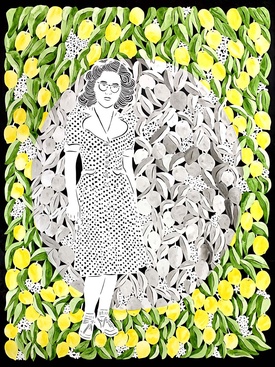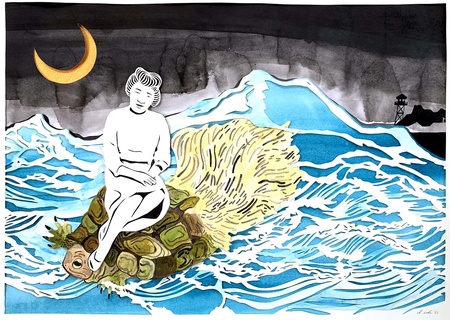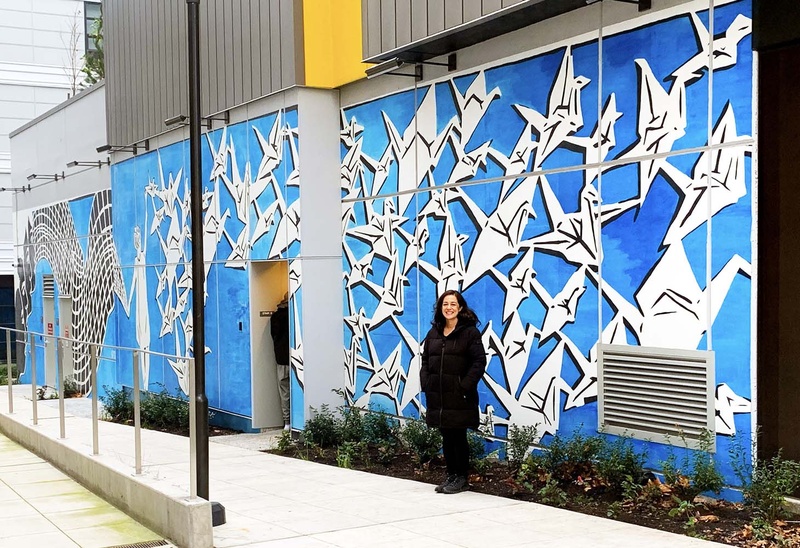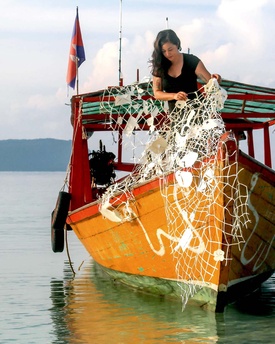Yonsei artist Lauren Iida and I first met online years ago when I interviewed her from Cambodia. Since that conversation her arts practice has expanded and deepened, as has her entrepreneurship and mentorship—all of these factors making her career an exciting one to watch. Her beautifully evocative paper cutting artworks include Memory Net, the series 100 Aspects of the Moon, and the series 32 Aspects of Daily Life. Many of them draw on her Japanese American heritage and historical research, and are often inspired by old family photographs.
In recent years Iida’s work has reached larger audiences, with her work being translated to murals throughout the Seattle area as well as Cambodia. In March 2021, along with a spike in anti-Asian attacks across the United States, one of these public art pieces was vandalized. Inspired by the Japanese artisan tradition of kintsugi, Iida chose to retain and highlight the damage by stitching together the piece with gold joinery.
Iida currently divides her time between her hometown of Seattle and Siem Riep, Cambodia. According to the studio’s website, “Open Studio Cambodia is an artist collective based in Siem Reap, Cambodia, the gateway to the ancient temples of Angkor Wat. Founded in 2018, Open Studio Cambodia mentors, represents, and provides supplies and communal studio and gallery space to a small group of local contemporary artists.” Among her many projects, Iida has also been working as the Artist-in-Residence with the Japanese American history organization Densho.
While on an extended visit back to Seattle, Iida took some time to speak with me over e-mail about the scope of her career and her powerful upcoming Seattle exhibit in January 2022.
* * * * *
Tamiko Nimura (TN): What role has your Nikkei identity and family history played in your artistic career?—When did it begin to play a role, and have you seen that role change or develop over time for yourself as an artist?
Lauren Iida (LI): My art practice has become a way for me to explore my Nikkei identity and a lens to reflect on it through. Creating art about Japanese American history has led me to focus on research throughout my art career in a comprehensive way that continues to evolve and take me down new paths of investigation.
TN: Who would you describe as your artistic influences in your paper cutting artwork? What about in your entrepreneurship?
LI: My paper cut artwork, which I’ve now expanded to include permanent substrates for large-scale public art projects—such as cut metal, tile mosaic, and painted mural—is mostly focused on my JA heritage in recent years. I have always gathered inspiration for my work from my personal experiences and immediate environment, which have also included my Pacific Northwest roots and my long relationship with Cambodia.
I have been working on social entrepreneurship and artistic mentoring projects in Cambodia since 2008 and I still support emerging artists through my project founded in 2018, Open Studio Cambodia.
TN: While part of your artistic process with intricate paper cutting has meant—in the case of one of your famous works, Memory Net—letting the works go, once they disintegrate. (As a writer invested in the permanence of my work, I’m fascinated by this part of letting the work go.) Can you say more about how the “letting go” is part of your process? How does it feel to let these go?
LI: The Memory Net, an ongoing temporary installation piece made from 30+ feet of hand-cut paper, is ephemeral in nature. The Memory Net “dredges up memories” which are expressed as symbolic objects “trapped” in the cut paper net. We can revisit these memories, then let them sink back down to the undefined space where memories exist. These could be memories of a place, memories of individuals or collective memories of a community. We don’t necessarily live everyday with our memories, good or bad, but the Memory Net project offers a way for us to temporarily revive and honor the memories which will always exist on some unseen plane of existence.
The destruction of these paper nets is purposeful on my part, as I play with them and travel with them, I capture photos to keep but let the fragile net go back to the Earth, knowing I will always cut another one.
Here is a statement by Kascha Snavely (owner of The Vestibule art gallery in Seattle) that helps to explain more about this work.
Casting the Net (Wall text)
In English, we say we’ve “lost a memory.” The phrase suggests memory has been dropped, misplaced, but not gone. A memory, a loss, may seem absent in our lives but still present in some other way, perhaps on an unseen plane of existence. We say we “dredge up” a memory. The memory sinks, drifts, but with the right line, we might catch it – an object pulled up from the deep.
We may live in one home and miss another as the artist does living between her two homes, Kampot, Cambodia and Seattle, Washington. Not having a permanent physical ‘home’ space to refer back to, as many people do, she finds herself adhered to the structure like a snail shell. Perpetually nomadic, the artist carries her net from place to place. It is simultaneously an appendage, a burden, a source of inspiration and a safe place of refuge. From this amalgamation of tangible representations of once exclusively ephemeral memories, a structure is woven which then becomes her new “home.”
The Memory Net is cast to dredge up objects from homes here and now, and if possible, to bring them to the surface again. In the paper, the loss shows up as it is: an absence, a loss of paper. In the light, the missing paper leaves us with nothing but a cast shadow. Memory objects are snared long enough to make sense of them but too fragile to touch.
TN: A related question—some of your works are now permanent public art installations. Do the permanent installations feel different from the more temporary paper art pieces, and how?
LI: Yes, I have been working on several public art projects in the last few years, including the Redmond Sound Transit Station (tile mosaic), a mural for Plymouth Housing (painted mural), and the Washington State Convention Center Addition (cut metal), among others. I love to see how versatile my cut paper can be, as it bridges the gap between 2D works on paper and 3D sculptural installation. I love sharing the Memory Net and other images with the public, presented in large-scale public art form, and I really look forward to continuing in this direction.
TN: At Open Studio, the artist collective you direct in Cambodia, you live, work with and mentor other artists. Can you talk about the role of mentoring in your artistic career? What does your mentoring look like now (mentoring other artists), and what (or who, as role models) prepared you to mentor?
LI: I work with a small group of emerging Cambodian contemporary artists through my project founded in 2018, Open Studio Cambodia. The artists I mainly work with are from impoverished backgrounds, and have beat the odds to pursue their fine art careers. One artist, Kim San, is a former Khmer Rouge refugee and master oil painter. Morn Chear has seen great success as a print maker despite losing both his arms in a tragic accident. Van Chhovorn is a painter who tells his story of being enslaved on a fishing boat for years through his artwork. Open Studio Cambodia started out in my home studio on a very small scale, simply giving high quality art making materials to emerging Cambodian artists in my area. Four years later, Open Studio Cambodia has hosted several exhibitions in the USA, Paris, and all across Cambodia. The artists we support are still thriving through Covid as we have learned to adapt to online sales and staying connected remotely.
My love affair with Cambodia started in 2008 when I ended up there as a tourist, but I didn’t start seriously working in the arts there until 2018. Due to the Khmer Rouge’s targeting of artists and creatives in the late 1970s, the art scene in the country is still only now recovering and starting to make waves in the region. Seeing the need[s] of struggling artists—often self-taught and living in extreme poverty—was my initial motivation to see what I could do in terms of skills sharing, donating art supplies, and advising on best practices, which eventually turned into more of a long-term mentoring and representation role.
I think my biggest influences for this kind of work were my most caring teachers at Cornish College of the Arts, the helpful and generous Artxchange Gallery, and my experiences working in arts education in Seattle with homeless youth and adults in recovery through Sanctuary Arts and Path With Art.
TN: Tell us a bit about your upcoming exhibition, Citizen’s Indefinite Leave, opening at Seattle’s ArtxChange Gallery in January 2022. Would you describe it as an extension of (or a departure from) your past work, and how?

LI: My next solo exhibition opens at Artxchange Gallery on the 6th of January from 5-7 PM (First Thursday Art Walk Pioneer Square) with an additional reception on the 15th of January from 1-4 PM (mandatory pre-registration for entry times). I am looking forward to presenting this new body of work which is both an extension and departure from my past work. During the isolation and uncertainties of COVID, which I mostly spent in Cambodia, I began to contemplate the concepts of confinement, isolation, and access to places we call “home.” I related these concepts back to the incarceration of Japanese and Japanese Americans, including my family, during WWII and created a new body of work in hand-cut paper and vivid watercolor, as [I] processed what was happening to me and what had happened to my ancestors.
In terms of technique, I used a lot more color in this series than in my previous work. I used watercolor, ink, and acrylic, often layered, to bring new life to historical photos and play with new themes of plant life and traditional Japanese mythological characters.

I was very privileged to have the opportunity to work closely with Densho, as one of their artists-in-residence for 2021. This gave me full access to their archivist, who helped me track down some specific information about my Japanese immigrant ancestors and their experiences from first arriving in the US around 125 years ago. With deeper research, this body of work is by far my deepest dive into my family’s history and I’m really excited about sharing this work with the public.
© 2021 Tamiko Nimura









